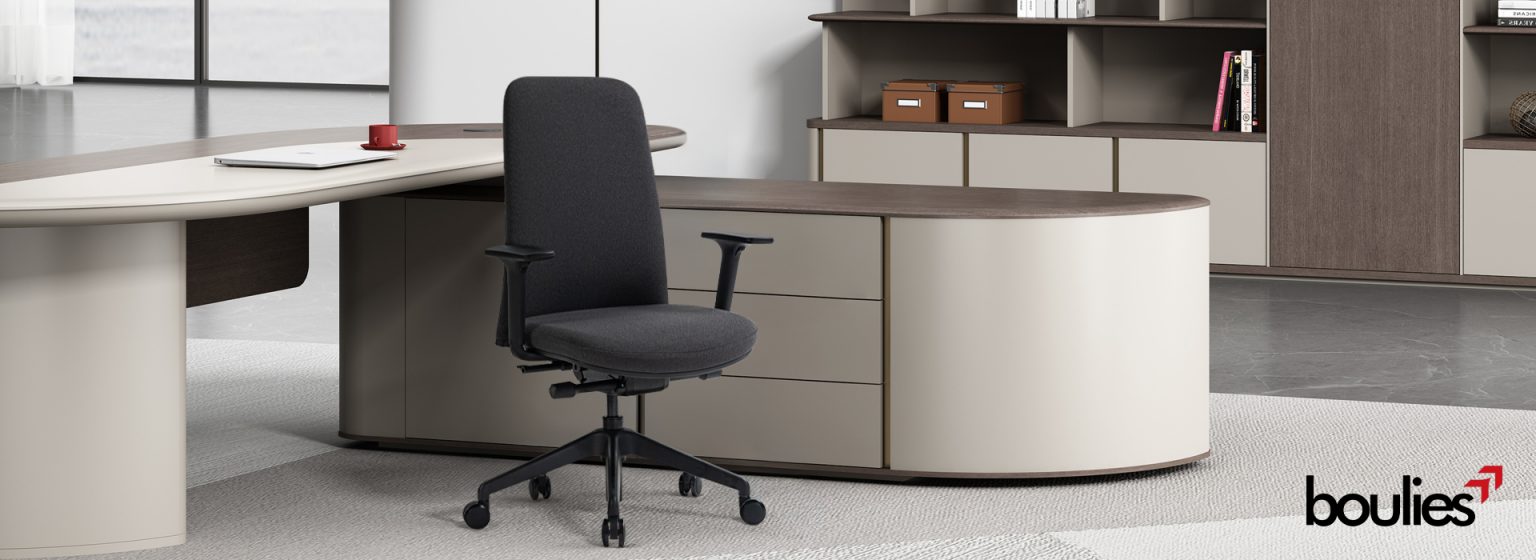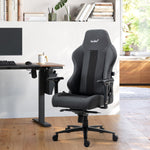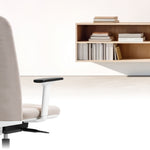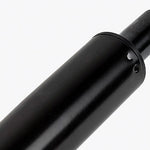Table of Contents
Learn how lumbar support helps maintain a healthy spine, prevent back pain, and improve posture—whether at work or home.
The gentle curve in your lower back silently suffers while you work. Those five vertebrae—the ones sitting right above your hip bones—absorb more punishment than most people realize.
Watch someone at their desk for an hour and you'll spot the inevitable slouch creeping in, shoulders rounding forward, that natural curve slowly flattening against the chair.
It happens in homes and offices everywhere, this daily collapse of proper posture.
What exactly is lumbar support?
Credits: Physical Therapy & Hand Clinic of Hillsboro
Lumbar support isn't just fancy marketing for chair padding. It's about maintaining that gentle inward curve of your lower back where nature intended it to be. When that curve disappears (which happens about 20 minutes into most sitting sessions), your back starts protesting—maybe not immediately, but the damage accumulates.
According to Flokk ergonomist Sukhi Assee: "When a person sits in a slouched position, there's a lot of strain on the lower vertebra (L4 and L5)." The spine develops that unhealthy C-shape instead of the natural S-shape our bodies need.
Most of us don't think much about our lower backs until something goes wrong. The pain starts subtly—just a twinge after a long day. Then it grows.
Types of lumbar support
There are three main types you'll encounter:
- Fixed supports - built directly into the chair, can't be adjusted (not ideal since everyone's body is different)
- Adjustable supports - can be moved up/down or in/out (about 10 cm of adjustment range works best)
- External cushions - separate pieces you add to any chair
That last type rescues many backs in places where proper chairs aren't available. A simple roll (about 9 cm thick) positioned behind your lower back can transform an awful chair into something bearable.
The science behind it all
Research shows our spines function best when maintaining their natural curves. A study published in the Journal of the Canadian Chiropractic Association found that adding lumbar support redistributed pressure more evenly across the back.
Before adding support, pressure concentrated mostly in the pelvis. After adding it, pressure spread more evenly through the lumbar region.
This matters because concentrated pressure in one area means those parts quickly tire. Your muscles work overtime to hold your spine in position, and they eventually surrender. That's when the aching begins.
Finding what works for you
Proper lumbar support should rest against the small of your back, roughly 15-20 cm above where you sit. For someone 170 cm tall, the support should centre around the L3 vertebra (approximately 10 cm above your hip bones).
Too high or too low, and you're making things worse, not better.
"What most of us do is sit ON a chair when we should sit INTO a chair," explains Sukhi. Most people perch forward instead of scooting back where the support can actually do its job.
Material matters tremendously. Memory foam works brilliantly because it shapes to your body without pushing back too aggressively. Some cheaper supports are too rigid—like sitting against a brick wall. Others are too soft, collapsing under your weight.

Who needs it most?
The people who benefit most aren't just those with existing back problems. Anyone who:
- Sits more than 4 hours daily
- Uses multiple workstations
- Has a long commute
- Works at temporary desks
If you're using a bedroom pillow as makeshift support, stop immediately. Regular pillows are usually too thick (8-10 cm) and far too soft. They push your back forward unnaturally. Proper supports maintain about 2-3 cm of depth—just enough to fill the natural gap between your lower back and the chair.
Gaming chairs often come with removable lumbar pillows, but they're hit or miss. Some provide decent support, others just look the part without doing proper work.
Common problems (and practical fixes)
If your chair lacks proper support:
1. Add a small lumbar roll (about 12-15 cm thick)
2. Adjust your chair height so feet rest flat on the floor
3. Move the chair closer to your desk to avoid leaning forward
If your support feels too aggressive:
1. Try a softer cushion
2. Move it slightly higher or lower (even 2 cm can make a difference)
3. Check that you're sitting all the way back in the chair
For travel and temporary spots:
1. Inflatable supports pack small but work well
2. Memory foam rolls with straps stay in place better
3. Avoid using rolled-up coats or bags—they shift too much
The 25-minute rule helps tremendously. Most ergonomics experts suggest changing your position slightly every 25 minutes, even just leaning forward or back briefly. This keeps blood flowing and muscles engaged.
Real talk about costs
Basic lumbar rolls start around £15, while decent office chairs with built-in support might cost £200-500. Seems steep until you consider the alternatives—missed work days, GP visits, pain medication, physiotherapy.
One study suggested that proper ergonomics could prevent up to 60% of work-related back issues. That's a significant amount of saved pain and money. Your spine remembers how it's treated, and it always collects its dues eventually.
The overlooked details
Most lumbar supports need cleaning regularly. After months of daily use, they become breeding grounds for bacteria. A quick weekly wipe keeps built-in supports fresh, but add-on cushions need more attention. The fabric absorbs sweat and skin oils, even through clothes. Best to wash removable covers every few weeks.
Adjustable supports often wear out faster than expected. After about a year of daily adjustments, the mechanisms get temperamental. That smooth up-down motion turns jerky or gets stuck halfway. Sometimes the support just flops forward like a tired muscle giving up.

Some practical wisdom
For sitting at a computer:
1. Your back should touch the support
2. Feet should rest flat on the floor
3. Position your screen at eye level
4. Take short breaks to stand and stretch
For driving:
1. Position the support before starting your journey
2. Adjust your seat so knees are slightly lower than hips
3. Keep the steering wheel close enough to maintain bent elbows
4. Stop every hour for a quick stretch
Frequently Asked Questions
What exactly is lumbar support and why is it important?
It's the curved bit that stops your back from collapsing when you sit. Your spine has this natural S-bend – about the width of your thumb at the lower back – and without something propping it up, it flattens out. I measured mine once with a ruler pressed against my back.
Weird looks from coworkers, but worth it. Most cheap chairs ignore this completely. Your muscles get tired holding everything up all day, then your posture goes, then your back aches. Standing up helps but who remembers to do that? Not me with deadlines.
How do I choose the right type of lumbar support for my office chair?
Don't just grab whatever looks good online. I did that. Big mistake. Spent three months with a cushion that felt like someone poking me with a finger. Some people need those sausage-shaped rolls, others need wide pads. Depends on your back.
If you're tall like my dad, most supports hit completely the wrong spot. Try sitting in it for at least 20 minutes – that's when you'll know if it works. Those adjustable ones cost more but might be worth it if you're fussy. Or if you share chairs with someone built differently.
Do expensive ergonomic office chairs guarantee better lumbar support?
No way. My mate spent £400 on some fancy chair that looks like it belongs in a spaceship. Hates it. Says it pushes in all the wrong places. I found one for £120 in a clearance sale that's brilliant. The posh ones have more knobs and levers, but that doesn't mean they fit your body better.
Some of those mesh-back chairs are good though – they kind of adjust to you. The best chair I ever used was some ancient thing in a library. Wouldn't win any beauty contests but my back loved it.
Can lumbar support help with existing back problems?
Depends. My cousin swears his support cushion fixed his back pain, but the bloke next door says his made things worse. The studies are all over the shop – some say it helps lots, others say barely at all. Sitting adds loads of pressure to your spine anyway, about 40% more than standing.
If your back's proper bad, probably best to talk to someone who knows what they're on about rather than listening to chair salespeople. Sometimes the simplest solutions work best, not the ones with all the fancy adjustments.
How often should I replace my lumbar support cushion?
When it stops working! Mine lasted about 14 months before it went flat as a pancake. You can tell when they're done – they don't bounce back properly and end up about a quarter thinner than when new. The cover gets all stretched out too.
If you're sharing chairs with others in the office, they wear out faster – especially if someone heavy uses it after someone light. The foam just gives up. Some cushions smell a bit after a while too, which is gross. My boss just orders new ones every 18 months and doesn't faff about.
The bottom line
Our bodies weren't designed for sitting 8+ hours daily. But since most of us have to, proper lumbar support becomes essential kit. Whether it's built into your expensive ergonomic throne or it's a £20 cushion strapped to your kitchen chair, the principle remains the same: maintain that natural curve.
The difference between good and bad back support feels like night and day. The right support works like invisible hands gently holding your spine in its natural position. Too firm, and it creates new pressure points. Too soft, and it doesn't do anything useful.
Think of lumbar support as an investment in your future mobility. Your 60-year-old self will thank you for the attention you paid to these seemingly small details decades earlier.
Your back quietly keeps score of how you treat it. Every day spent with proper support is a point in your favour. Every day hunched over without it adds to the other column. The numbers always get tallied eventually.
Supporting your lower back properly isn't just about comfort today—it's about being able to garden, play with grandchildren, or simply stand upright without wincing twenty years from now.
Not all heroes wear capes. Sometimes they're just small cushions keeping your spine where it belongs.






